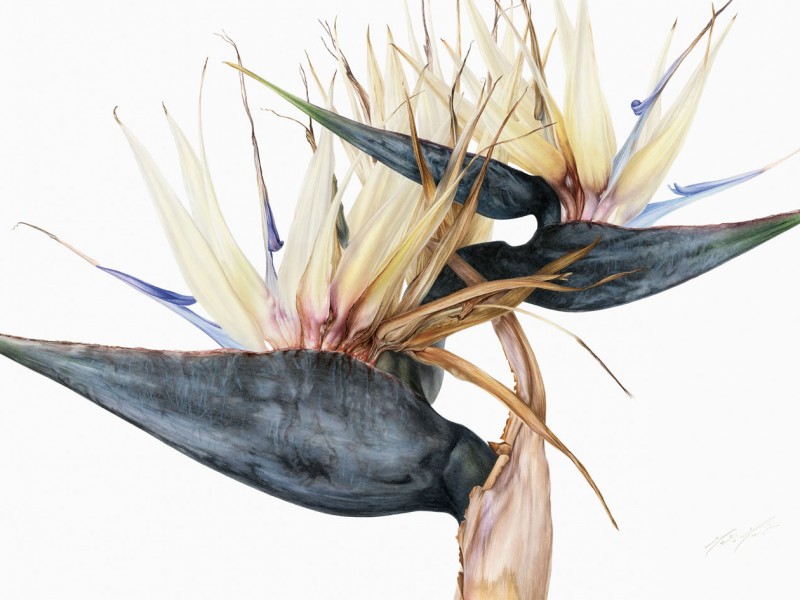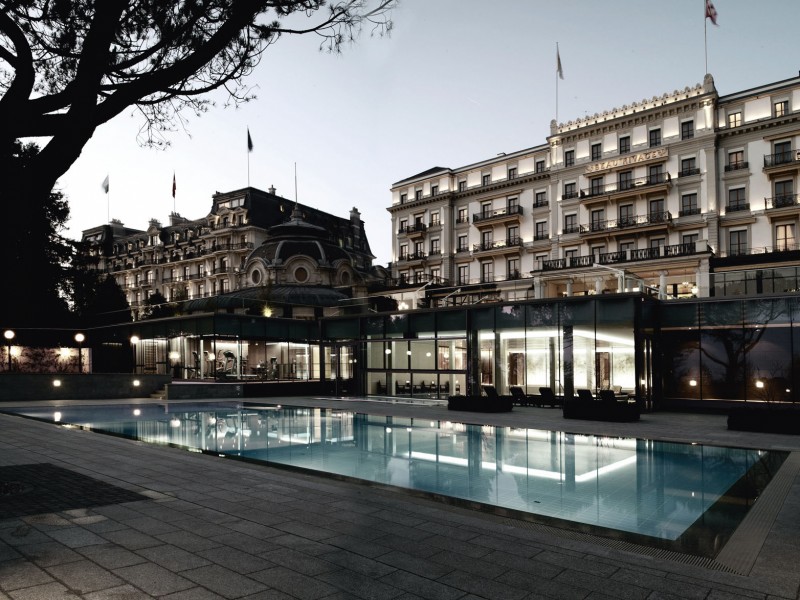Champagne, like philosophy, romance, loftiness, and insouciance, is one of the beaux arts of the French people. Nathalie Vranken, co-owner and head of the marketing division of Vranken-Pommery Monopole, embodies all of them with dauntless equipoise. She is self-deprecating and graciously curt; her sentences are drenched in introspective solemnity and fitful dreaming. She casts her French syllables with gentle sternness and strings her English with melodic lilt. Paris-born Vranken earned her degree in history at La Sorbonne and, in January 1987, founded the image and communications agency Nico Agency. But she doesn’t consider her current role in the family company, where her husband Paul-François Vranken serves as president, with expected bombast. “I am the least talented person in the company,” she cedes, as if suggesting that towering seats of authority may be a trap for free souls. “I don’t have the talent of making wine nor of making art.”
Her talents, then, may be in cultivating genius in those around her. “I am very good at convincing people, and it helps that I have natural authority,” she laughs, an effulgence rushing to plump the fine hollows of her cheeks. “My best feature is that when you look at me, you can sense my authority. It’s very difficult to go against me. Is it easy to work as a couple when you’re in the same company? No, it is not.” When asked what makes their partnership so strong, the words—and their gravity—can’t be conveyed quickly enough. “Because I am working for him,” she says, with preemptive speed. “I am not a woman who enjoys conflict, but there is no question about it: there is only one president in the company.”
After launching her agency, Vranken became an integral member of the Montaigne Committee, an association of all the luxury retailers on the Avenue Montaigne. She rose to director of the institution and spearheaded the launch of The Montaigne Grape Harvest, a biennial event that invites patrons to taste the company’s portfolio of champagnes and wines in-store. “Twenty five years ago, if you were young, and female, and you wanted to work in a nice business environment then the Avenue Montaigne was the best,” she says. That fashion and business—feminine wile and masculine cunning, traditionally—were neatly paired must have only whetted Vranken’s appetite, especially among the designers who ennobled womanly spirit. “All the usual suspects were involved: Dior, Chanel, Gucci, Prada, Saint Laurent, Armani and Versace were all there.”
Her work on the Villa Demoiselle, an Art Nouveau mansion on the foot of Domaine Pommery, was a feat of both lordly money and Nikean valour. The mansion was built between 1903 and 1908 according to plans by famed architect Louis Sorel and its first owner, Vranken believes, was Henry Vasnier, who was sole legatee of Pommery at the time. Vasnier had been a zealous collector of art by timely masters like Millet and Corot, and may have possibly wanted a palatial home to enthrone them. The mansion had been left abandoned for over 50 years when Pommery was finally acquired by Paul-François Vranken (who is from Belgium, one of the first wellsprings of Art Nouveau) in 2002. His first champagne cuvée, La Demoiselle, which had appropriated the vine and dragonfly motifs of Art Nouveau, made acquiring the Villa for the newly formed company seem like fate.
“It was logic,” Vranken says. One immediately suspects that she is more sensitive to cosmology than she lets on. “We started with the bouteille (bottle) Demoiselle, which is inspired by Art Nouveau. We went on to acquire Charles Lafitte, and then Heidsieck & Co Monopole. In 2002, we had the opportunity to buy Pommery. Are you following me?” She stuns you: whenever your mind might be toiling, her gaze succeeds in overriding its internal circuits. “In the Domaine Pommery, we found the most beautiful masterpiece of Art Nouveau—the Villa—which was closed and abandoned. So don’t you think it’s funny, or interesting, or esoteric, or philosophical? Think about the story: you had a guy, who decided to spend all his life in champagne, who made a special bottle inspired by Art Nouveau, that nobody else was doing. Then he made money with that, acquired Pommery, and in the Domaine Pommery there just happens to be a masterpiece of Art Nouveau? Is that not a destiny point?”
Though the Villa Demoiselle is now used for receptions and tours, Vranken is adamant that its spirit is wholly tied to hers. “She is 1,200 square metres, probably one of the biggest productions of Art Nouveau,” Vranken attests. “Even if it’s used for receptions and tours, it is still my house. I have made it, I renovated it, I did everything, even if I don’t live in it. I will never commit to that kind of work again: it took five years of my life. I was there every day.” The renovation budget remains undisclosed, but it required sundry craftsmen, decorators, plumbers, roofers, painters, carpenters and glass workers. The Vrankens waited patiently for the exact right marble stone for the fireplace, had missing pieces of wood sculpted one by one, and had the mosaic floor restored tile by tile. They scoured auction houses and antique stores to secure gems, including Paul-Alexandre Dumas’s monumental fireplace and a set of Serrurier-Bovy chairs at auction in Brussels.
“They share a certain idea of elegance,” Vranken hums, pondering the intersection of champagne and art. “That’s the best word for it. Art is not just the visual: it’s also the smell, the song, it can also be the taste, as we now have chefs professing to make edible art. It’s totally open to all five senses.” Vranken shuns the trappings of art’s absolutism, “I am totally eclectic,” she defends. Art Nouveau does however direct the conversation: “I adore Belgian Art Nouveau, and the work of Hector Guimard and Louis Majorelle in France. It depends on my mood and time of day,” she sighs, before admitting, “the only thing that is constant is how I feel for my husband”.
Vranken avidly crosses the threshold from spectator to participant, which she does in a formal capacity. Champagne Pommery has been sponsoring the Frieze Art Fair in London for seven years. In October 2015, Vranken presented The Stand Prize to the Stuart/Shave Gallery for its two-artist presentation of Mark Flood and Yngve Holen. “It’s important to be with the artist, and it’s important to be with the curator and open your mind to new things,” she says. Vranken quickly takes her phone out to present a picture of the Flood and Holen booth, which she had seen in London a week earlier. Displayed on the walls of the Stuart/Shave Gallery carrels are Flood’s paintings: abstracted spreads of neon colour, fogged along their lines so that they ape the paintings of Mark Rothko. A series of washing machines, installed by Holen, line the centre. Nestled on top of each one is a model airplane and magnified infrared photographs printed on silky sheets of perspex. “Fabulous, no?” she coaxes.
Vranken Pommery Monopole does not focus on an aggressive digital scheme, relying instead on the organic relationships it forges through staggering cultural partnerships. One of the champagne house’s major events is the Expérience Pommery annual art fair that attracts over 100,000 people to Domaine Pommery. “It’s a great opportunity to find what’s next, because I may get an idea for the new bottle, a new box, or for the next advertising campaign,” she says. “What we’re doing is for the wine, too, because, in a way, we consider our products to be works of art. It’s an exchange.” The basement vaults—the ‘caves’ of Domaine Pommery—house over 20 million bottles of champagne, which consort with the artists’ works in surfeits of reverent light. The company also partners with the French Ministry of Education to raise awareness of contemporary art: 800 students from 30 schools display their works in the caves. “I do a vernissage of their art, but with grape juice!” Vranken jokes.
Pablo Picasso once opined that every child is born an artist, but that too many unclench those soaring dreams as they grow older. “No, I wanted to be a princess, not an artist,” Vranken admits. “But today I know that life is work. A princess is desirable; believe me, but I am too old now.” Creativity might be a child’s first refuge from adolescent storms, but the work, Vranken demonstrates, remains a game of strategy well into adulthood. “The great function of creativity is making life appear. Without it there is no company, there is no way you can even live together. And you need to listen. If you don’t listen to the people around you, you can’t be successful.”
It’s no surprise, then, that she relays the advice of Madame Chirac, former First Lady of France, with such esteem: “she told me that you must always be rigorous, in life and in work”. Vranken breathes quiet, almost incorruptible intensity: her aura seems to smoulder and simmer at once. “But do you know what represents me the most?” She quizzes. “It’s not the champagne at all. It’s actually the bubble—because I’m sparkling!”
For more visit www.vrankenpommery.com
Related Features
-
51
-
-
-

